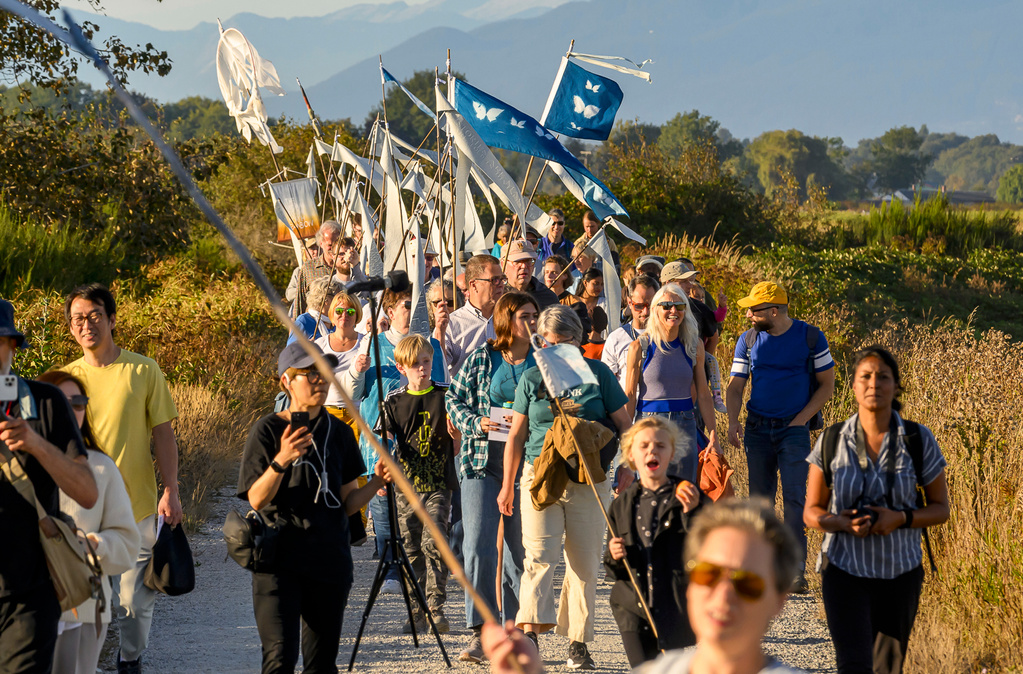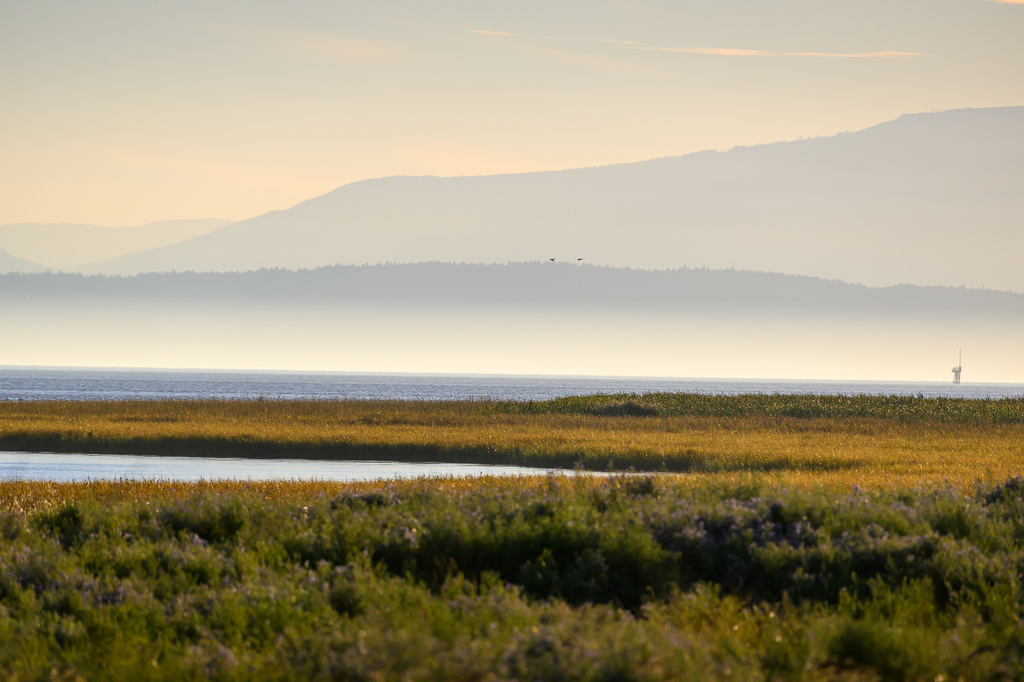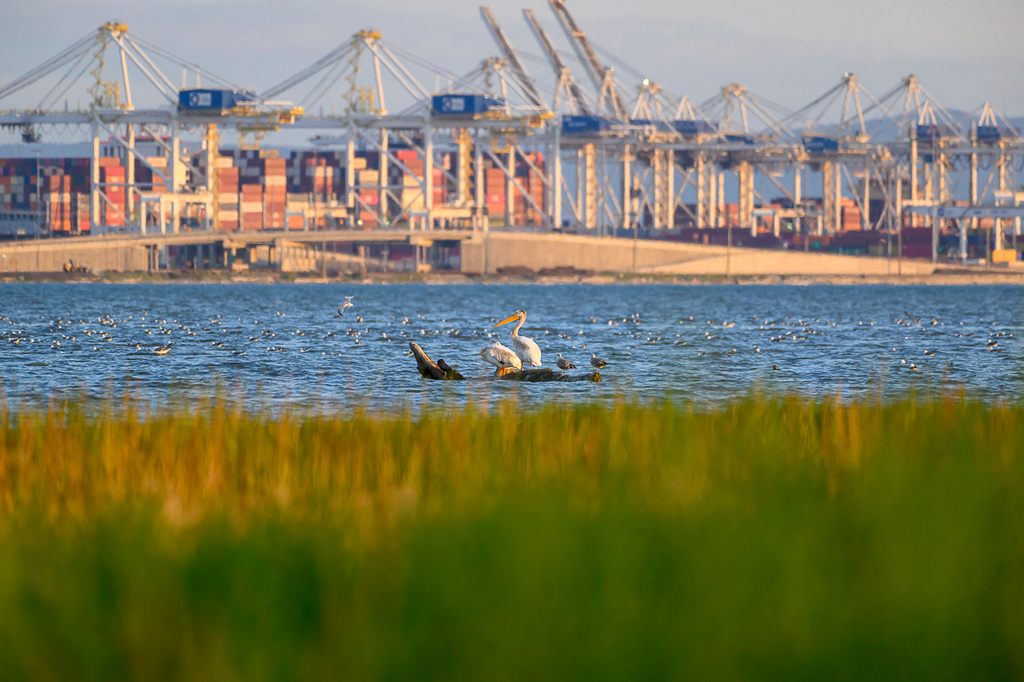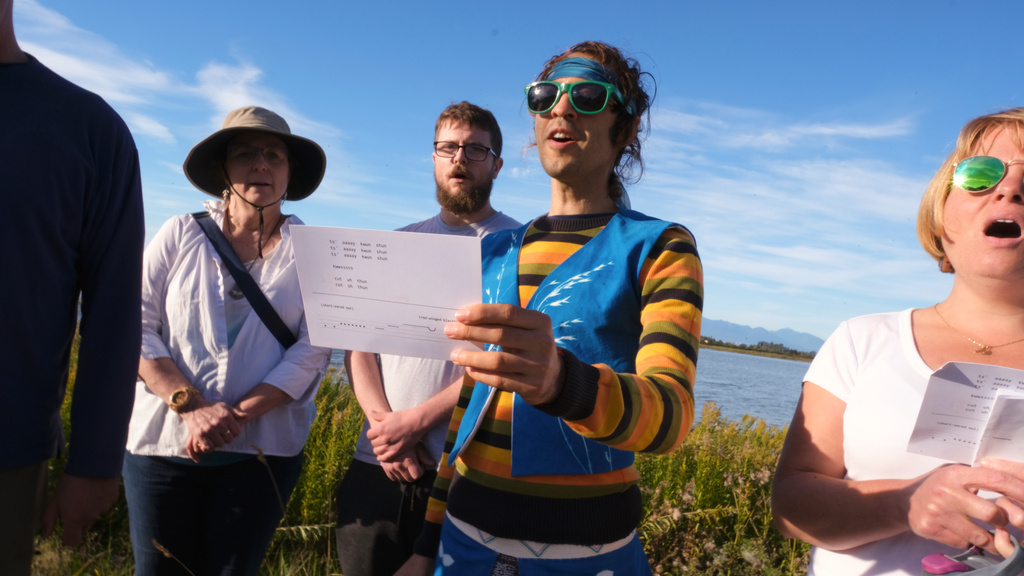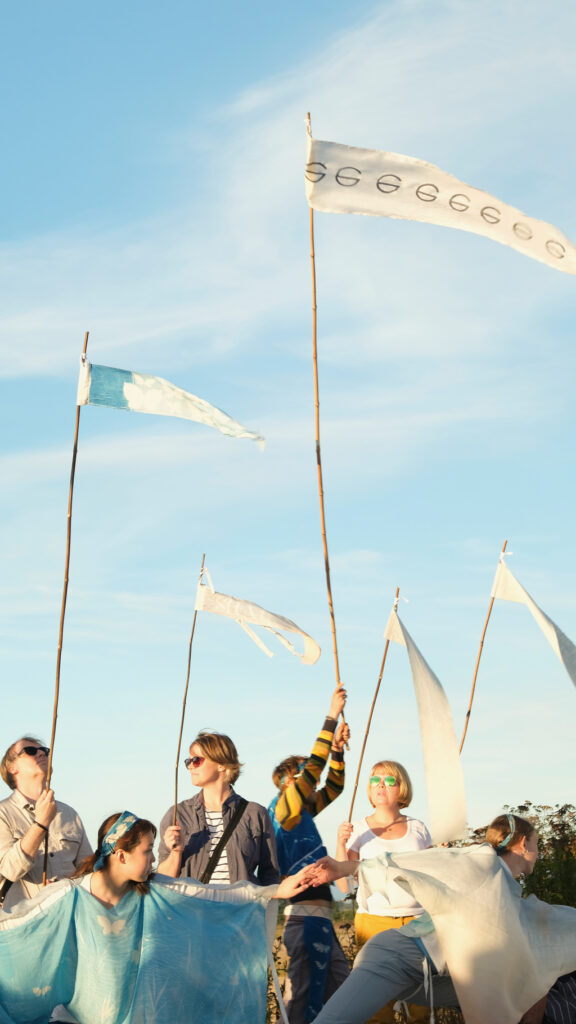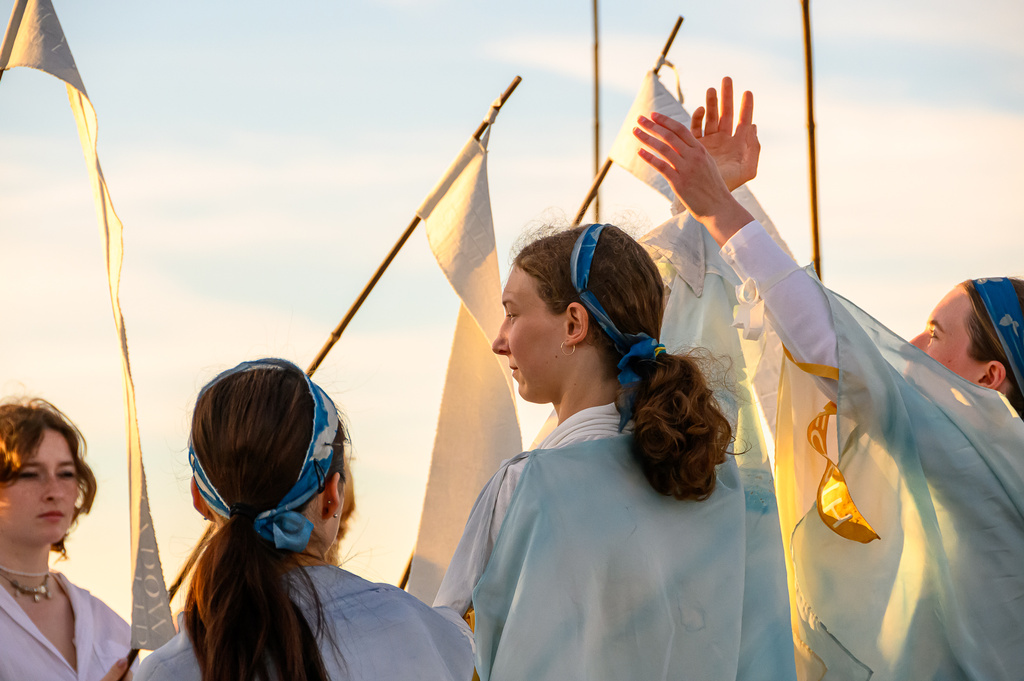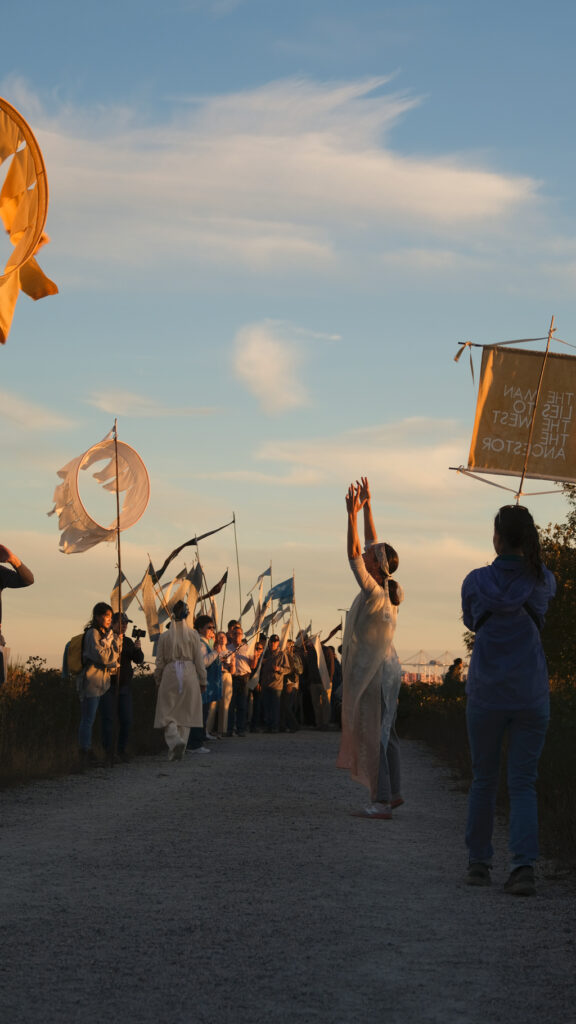James Casey talks with Amy-Claire Huestis about a performance procession at Hwlhits’um (Brunswick Point) to honour the endangered migratory shorebird.
(A message to the reader.)
As the sun set on the fall equinox in 2022, a site-specific performance took place at Hwlhits’um (Brunswick Point), on the ancestral and present-day lands of Salishan Peoples, on what is now called the Fraser River, in British Columbia, Canada. It is a key stopover site for migratory shorebirds on the Pacific Flyway—critical habitat now threatened by the expansion of a shipping terminal. The event was part of the efforts to save a small piece of this world for shorebirds and other life on the Pacific Coast of the Americas.
The following is a conversation between conservationist James Casey and artist Amy-Claire Huestis about MOTHLIKE/silvery blue, Amy’s participatory and collaborative piece for dance, choir, and community.
James: Have you been out on the mudflats? Actually, walking in the mud?
Amy: I have been invited to go out there, but I feel like it’s a place for the birds—it’s not for people, except scientists, of course.
James: Yeah, I understand that. Still, there’s something about being on the mudflat—being in amongst the reeds, taking samples of biofilm as the birds are feeding—to feel the fine sediment sucking at your feet, and being surrounded by birds as you’re there, trying to do work to protect the habitat.
In your performance, being near the mudflats with a community of people with a shared interest in maintaining the place, it was an intersection of learning for me, with the birds.
Amy: I wonder if you could close your eyes and recount for me what it felt like and what it looked like to carry the flag during the performance.
James: It began with the feeling of responsibility, of trying to do a good job, participating. And there was the opportunity to share it with my wife, Katharine, and other colleagues, and to have the conservation community coming together, with their families and other folks in the community. And to have a way into the work that wasn’t guarded by a technical requirement, like bird watching or citizen science surveying.
There was a solemness—maybe because for some of us there are concerns about extinction. There are hundreds of thousands of shorebirds that are at stake at this site.
With the engagement of the Indigenous communities that have lost so much on the land, we heard some of that shared. Hearing Hwlitsum First Nation speak and reflecting on our past failures as settlers—this is intertwined with my concerns about the current decision-making.
But then, as I walked and listened to the choir, I was able to settle into looking out over the mudflat and the marsh habitat, and the waving of the flag integrated with the waving of the grass and the movement of the waves out on the flats. I felt the wind come up over the point. And the flags matched what was happening out on the grass.
And I was witnessing the community walking back and forth in procession, the kids having fun, but at the same time respecting and trying to connect with the place.
- Hwlhits’um (Brunswick Point) on the Fraser River, 2022 photo: Simon Shutter
- The Roberts Bank Shipping Terminal, 2022, photo: Simon Shutter
- Composer Omar Zubair sings with the choir in “Welcome Song,” beginning the performance. He sings the hul’q’umi’num’ words, “ts’ekwun shun kws qututhun,” gifted by esteemed Cowichan Elder, Dr. Luschiim Arvid Charlie, meaning “walk with respect and honour for friends, family, and the earth on the shoreline.” MOTHLIKE/silvery-blue performance 2022: photo: YaWei Lin
- Composer Omar Zubair carries the Eeeee flag in the performance, 2022, photo: YaWei Lin
- Dancers Ellen Harris, Twyla Raffé-Devine and Lina Baang perform in MOTHLIKE/silvery-blue 2022, photo: Simon Shutter
- At right: dancer Rachel Harris, followed by biologist Amie MacDonald in the performance, 2022, photo: YaWei Lin
And then, watching Jody Sperling dancing, that resonated with me and reminded me of the murmurations of the shorebirds. It was an echoing of the connection. But it was also a bit melancholy, because it isn’t receiving the protection it needs.
Amy: As Jody danced, the choir was reading and singing about the spirits in the marshland and naming different animals. We were bringing them into the piece in kinship. We were singing “eeeeeeeee,” which is the sound I give to the butterflies. It might have been solemn because we were singing the language of an ecological ghost, because the butterflies have disappeared from the site.
We were being uplifted and solemn and grieving at the same time, because that’s what that place is like. You can see a murmuration of the sandpipers, and it’s one of the wonders of the world—you’re so uplifted. And then, the knowledge settles in while watching the awesome and glorious sight—you remember that they will go extinct soon.
James: And then seeing the costumes, they stepped outside of capitalist systems of production that drive what’s happening on the Delta. The expansion of the Port of Vancouver is about expanding big consumerist activities, like fast fashion.
Amy: My collaborators and I, we wanted all of this to happen for people. I wanted my flags and costumes to speak the same language of the place. I think they did because they were painted with earth pigments, and those earth pigments light up and resonate in the landscape. The sun was setting, and the flags were lighting up with that warm light of the sun, and the costumes were lighting up with those earth colors.
And then, it was profound to see people that I care about, to see the community and people who have an invested interest like yourself, carrying flags and being with the artwork and performing it.
For instance, at the end, we all lined up to watch the sunset, and we were all singing softly—it was a prolonged moment where Rachel Harris danced, walking slowly past us. She was wearing strips of silk—one strip said AOAOAO, which is a sound that the port makes, and other strips had words about becoming the sunset. Rachel passed me slowly, and then, a few steps later, Amie MacDonald (biologist, Birds Canada) passed me slowly. Amie was carrying a flag, and she was very graceful, walking at the same pace. That was striking, to see the dancer and the biologist choreographed together.
James: The things you made and the experience you offered—it is a complex amalgamation of what’s playing out at that site. So often, we have to articulate one perspective and deliver on a technical objective in a communication piece, like when we provided public input to the Roberts Bank Terminal 2 process. We had to focus on population numbers and scientific rationale explaining the likely impacts of port development on the shorebirds. To be actively engaged in the ceremony at the site allowed for more complexity.
Amy: It’s the complexity of language, of attention, of knowledge. That’s where culture is so important. Culture provides this complexity. Lindsay MacDonald, the Hwlitsim knowledge holder—of Hwlitsum First Nation, who carry the name of the site, (Hwlhits’um)—he said, “people just don’t know what they’re looking at when they’re here.” There are so many layers to the place. It goes so deep. It’s a giving place. It’s a nurturing place, the place where the shorebirds come to eat.
During the performance, the site really lit up. It did its show for us. Did you feel that?
James: I did find it lit up. The marsh really was at its best.
We’ve lost so much of our ability to understand the meaning in places and things, both in interaction with places and with things that are made with more care.
Amy: As an artist, I want to be integrated in my community, and I want my artworks to be integrated with the place.
And then I think it’s important to model for people that you love nature and you are connected. And the flag was the conduit for this—to connect people to the place and to the wind and the heavens.
About Amy-Claire Huestis
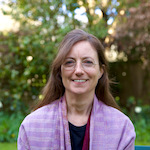 Amy-Claire Huestis is a settler artist living on the Salishan Lands of the Fraser River Delta, where she creates works about birds and their habitat, seeking ways to find connection with these more-than-human kin. She teaches painting and drawing at Kwantlen Polytechnic University in British Columbia, Canada. For the MOTHLIKE/silvery blue site, Amy also co-curated a community-guided walk, “walk quietly / ts’ekw’unshun kws qututhun”, at Hwlits’um (Brunswick Point in Ladner, BC).
Amy-Claire Huestis is a settler artist living on the Salishan Lands of the Fraser River Delta, where she creates works about birds and their habitat, seeking ways to find connection with these more-than-human kin. She teaches painting and drawing at Kwantlen Polytechnic University in British Columbia, Canada. For the MOTHLIKE/silvery blue site, Amy also co-curated a community-guided walk, “walk quietly / ts’ekw’unshun kws qututhun”, at Hwlits’um (Brunswick Point in Ladner, BC).
About James Casey
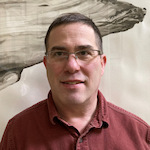 James is an environmentalist and woodworker from the coast of British Columbia, Canada. His day job is seeking ways to restore the relationships between people and the natural world. But through his woodworking, he explores the tension between order and the unknown as expressed in the process of transforming trees into furniture.
James is an environmentalist and woodworker from the coast of British Columbia, Canada. His day job is seeking ways to restore the relationships between people and the natural world. But through his woodworking, he explores the tension between order and the unknown as expressed in the process of transforming trees into furniture.

